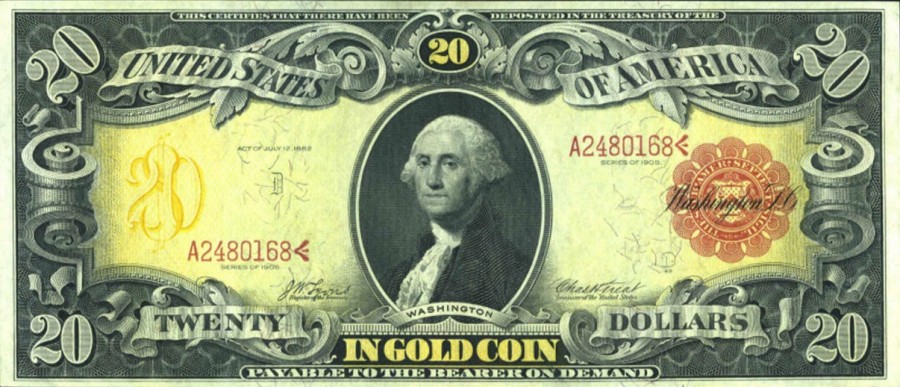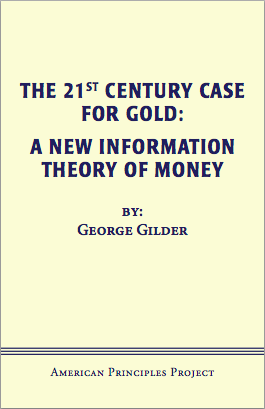John Tamny is one of the most Hazlitt-ian writers of the modern era — a true treasure when it comes to elucidating free market principles, and in particular making the case for sound money simple. As a brief aside, I had the chance to speak with the RealClear Markets editor and Forbes Political Economy editor about his “Popular Economics” here, a conversation I relished.
So it should could as no surprise that Tamny’s review of prolific writer, futurist and Reagan’s most quoted living economist George Gilder’s new monograph, The 21st Century Case for Gold: A New Information Theory of Money, would contain a wealth of insight.
Gilder’s revolutionary application of information theory to economics was presented comprehensively in a 2013 title that deserves more attention than it has received to date, Knowledge and Power. Here’s a handy listicle I published that provides a substantive overview of Gilder’s work.
At its most simple, Gilder argues that information is the key to all economic growth. If it has a clean medium in which to be disseminated — namely an environment in which private property rights are protected, taxes are low and money is sound — we will flourish.
Here is how Gilder puts it:
Entropy is a measure of surprise, disorder, randomness, noise, disequilibrium, and complexity. It is a measure of freedom of choice. Its economic fruits are creativity and profit. Its opposites are predictability, order, low complexity, determinism, equilibrium, and tyranny. Predictability and order are not spontaneous and cannot be left to an invisible hand. It takes a low-entropy carrier (no surprises) to bear high-entropy information (full of surprisal). In capitalism, the predictable carriers are the rule of law, the maintenance of order, the defense of property rights, the reliability and restraint of regulation, the transparency of accounts, the stability of money, the discipline and futurity of family life, and a level of taxation commensurate with a modest and predictable role of government. These low-entropy carriers do not emerge spontaneously. They are the effects of political leadership and sacrifice, prudence and forbearance, wisdom and courage. Sometimes they must be defended by military force. They originated historically in a religious faith in the transcendent order of the universe. They embody a hierarchic principle. It is these low-entropy carriers that enable the high-entropy creations of successful capitalism.
And a bit more:
Economic growth springs not chiefly from incentives—carrots and sticks, rewards and punishments for workers and entrepreneurs. The incentive theory of capitalism allows its critics to depict it as an inhumane scheme of clever manipulation of human needs and hungers scarcely superior to the more benign forms of slavery. Wealth actually springs from the expansion of information and learning, profits and creativity that enhance the human qualities of its beneficiaries as it enriches them. Workers’ learning increasingly compensates for their labor, which imparts knowledge as it extracts work. Joining knowledge and power, capitalism focuses on the entropy of human minds and the benefits of freedom. Thus it is the most humane of all economic systems. [Emphasis mine]
In his RealClearMarkets review of Gilder’s new book on money, Tamny makes four critical points in particular:
1) On the “seen and the unseen” of currency speculation attributable to centrally planned money
So unstable is money today that as Gilder writes, currency traders are trading the chaos to the tune of “$5.4 trillion every twenty-four hours.” Important here is that currency trading is no easy feat. We’re talking about talented people. Thinking about Gilder’s all-important elevation of information as the source of prosperity, it should stagger us to consider all the cancer cures, software innovations and transportation advances never achieved thanks to so many great minds being compensated for mitigating the economic stagnation that floating money represents. It’s the unseen that most who presume to comment about economics never consider.
2) On the “fatal conceit” of our enlightened econometricians and political elite
With the ‘70s in mind, not to mention the generalized conceit within the profession that says they can “measure” the infinite decisions taking place among billions every millisecond, that economists are monolithic in their dislike of gold-defined money is a feature of stable money, not a bug. We’re talking about a class of academics who would spend years pursuing a degree to allegedly understand that which is common sense (human action). Thankfully Gilder is not an economist, neither is Forbes, neither was the late Robert Bartley of the Wall Street Journal, nor was Adam Smith – the list is long.
3) On the inherent flaws of monetarism
Indeed, the basis of monetarism is that the central bank (in our case, the Fed) can control the supply of money. Not only is the latter presumption laughable considering the global nature of dollar-denominated credit, it flies in the face of basic common sense. If this is doubted, readers might imagine impoverished Baltimore for a moment, and what would happen if the Fed deposited $1,000 in the account of each resident. To monetarists this scenario would foster a Charm City boom, but realists would acknowledge that the $1,000 per resident would depart Baltimore almost as quickly as it arrived. As evidenced by the lack of economic activity that presently defines the city, it’s fair to say that banks there would quickly lend the money to concepts well outside Baltimore itself. As for those who would spend the dollars, the best shopping options are similarly well outside Baltimore’s city limits. Credit exits countries as easily as it does cities. The only closed economy is the world economy.
More realistically, and for that matter logically, money supply is demand determined. As Gilder stresses throughout his monograph, we the people control the supply of money, and we do so based on our production. When we produce we’re demanding the broadly accepted “money” that is exchangeable for market goods. That’s why there’s lots of money in Palo Alto, but very little in neighboring East Palo Alto. Where there’s production there’s never a problem of “deficient money supply.” Implicit in the monetarist view of the world, and this is odd given how many consider themselves free-market advocates, is that production can be planned. What else could explain their designs to plan the supply of money? To purport an ability to control or plan the supply of money is to by definition presume to plan the amount of production in a city, state or country. This is why monetarism has always failed, and it’s also why Gilder thankfully spends a great deal of time exposing a form of central planning that is so inimical to economic growth, and yes, freedom.
4) On the superiority of the gold standard
Gilder’s solution to the question of money is to once again define the measure in terms of gold. There’s no real mystery as to why he supports this monetary approach. As he explains it, “gold is the monetary element that holds value rather than dissipates it.” That’s of essential importance simply because as opposed to it being a commodity, good money is a concept rooted in stability of value. Gold holds its value the best, and since money is a measure of value, it’s best to define it in terms of gold.
This is stuff they simply do not teach you in school, which explains in part why our elites are so economically illiterate.
Featured Image Source: Wikipedia Commons.





Leave a Reply